Articles
Electric Shock Case Study 2: The Shower Block Shock at a Quarry
Case Study 2: The Shower Block Shock at a Quarry

This case study stems from a quarry in NSW. This was the background situation before the incident occurred.
- There has been mining on the site for well over a century
- The amenities block was from the 1970s
- The electrical system had been heavily modified over many years, and the documentation of changes wasn’t always perfect
- A new site electrical engineer recently started
- The hot water had recently failed in the amenities building, and electrical staff had attended to try and remedy the problem
The Incident?
- Maintenance worker – end of shift
- Worker covered in oil and needed a shower
- Turned on taps, and felt something, assumed it was cuts on his hands
- Water didn’t get warm
- Had a cold shower, hot water not working
- Went to turn off tap, realised he was feeling an electric shock. Uncontrolled gripping.
- Made all the right decisions – Vacated shower, called for help and didn’t turn off the water.
Immediate Steps
- Help arrived and turned off power.
- Tested tap voltage, and nothing there.
- Turned taps off.
- When leaving the bathroom, they noticed water from ceiling which was unusual.
- Area secured ready for investigation.
- Victim taken to hospital for treatment and was fine.
Hazard Created & Survived
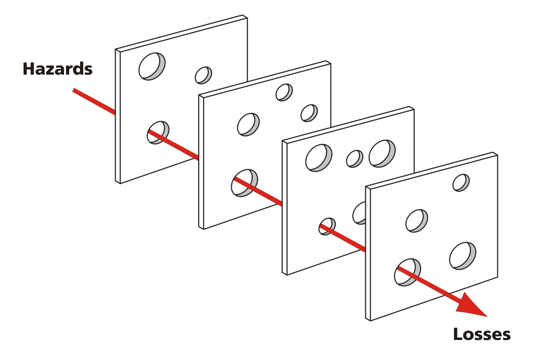
This case study relates to the Swiss Cheese Model – formally propounded by James T. Reason in 1990 where he recognised:
“Accidents in complex high-risk technologies had their primary origins in a variety of delayed-action human failures committed long before an emergency state could be recognized. These disasters were due to the adverse conjunction of a large number of causal factors, each one necessary but singly insufficient to achieve the catastrophic outcome.” Source
In the case of the “Shower Block Shock” eventually the large number of casual factors from decades of errors and violations lead to the electric shock. The post-accident investigations showed:
- Many mistakes were made over the years
- Some of them a long time ago and few were corrected/fixed
- Each individual problem on its own was not enough to cause a problem
- When they all happened in conjunction, the result was catastrophic
- This is the Swiss Cheese Model
What happened in this incident?
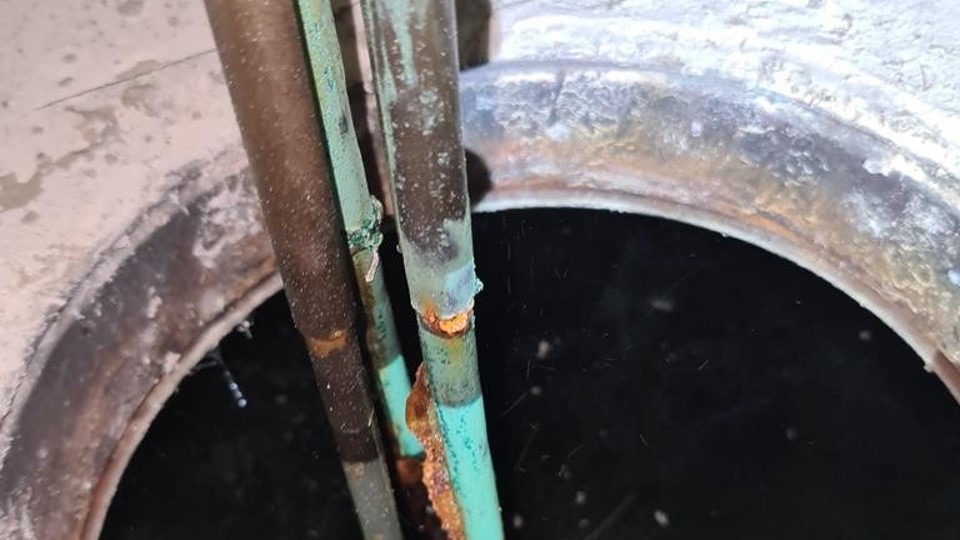
In summary the hazard was created by:
- Water from the ceiling was from the old hot water system. In the past, a new hot water system was installed near to the distribution board, but they forgot about the original hot water system in the roof space.
- The original system wasn’t decommissioned, it was left plumbed up, wired up, and the breaker wasn’t labelled, locked out or removed.
- At some point an electrician was called because of cold showers. They discovered on inspection of the distribution board that a breaker labelled hot water was open.
- What did they do? They closed the breaker and walked away. The closing of the breaker created a hazard sitting on the system. This breaker should have tripped causing an investigation, and the avoidance of this shock incident.
- The person who closed the breaker had dry hands, was wearing boots, and standing on dry ground. But the breaker didn’t trip.
Why didn’t it trip?
It related to AS/NZS 3000:2018 LV configurations:
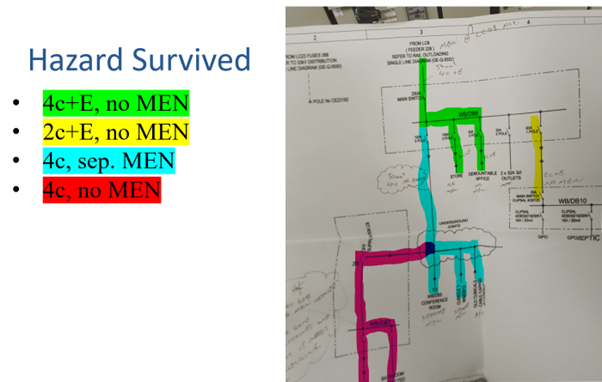
To ensure a low impedance path back to the source we needed either a protective earth returning to a MEN link, or for outhouse buildings, the creation of a new MEN link, with protective earths distributed from there. The onsite staff were not familiar with their plant so pulled out SLD and had a look around.
The configurations:
- 4C+E, no MEN. Fine because protective earth going back to upstream MEN.
- Same with 2C and Earth.
- 4C, has no protective earth, but going to outhouse buildings with new MEN links.
- Last one, 4C also but that outhouse building does NOT have a new MEN link.
This was the supply to the amenities block.
The Fault Circuit – Diagram 1

Relating to the above fault circuit diagram:
- Upstream source from transformer. No protective earth on the supply.
- Distribution board with no MEN link and a hot water service with a heating element in it.
- We’ve got a shower, and the shower plumbed up to the hot water service and earthed back through to the distribution board.
- Normally we have power running through this circuit, through the heating element, the water gets hot, everyone happy.
- In this case we have a fault in the hot water system. What happened instead was the power ran through a circuit and jumped out of the wiring, into the plumbing, and then went through the earth, through the distribution board and into the earth stake.
- There was no low impedance path via an MEN link or protective earth back to the source and because the circuit wasn’t wired as per AS3000 it relied solely on the earth stakes.
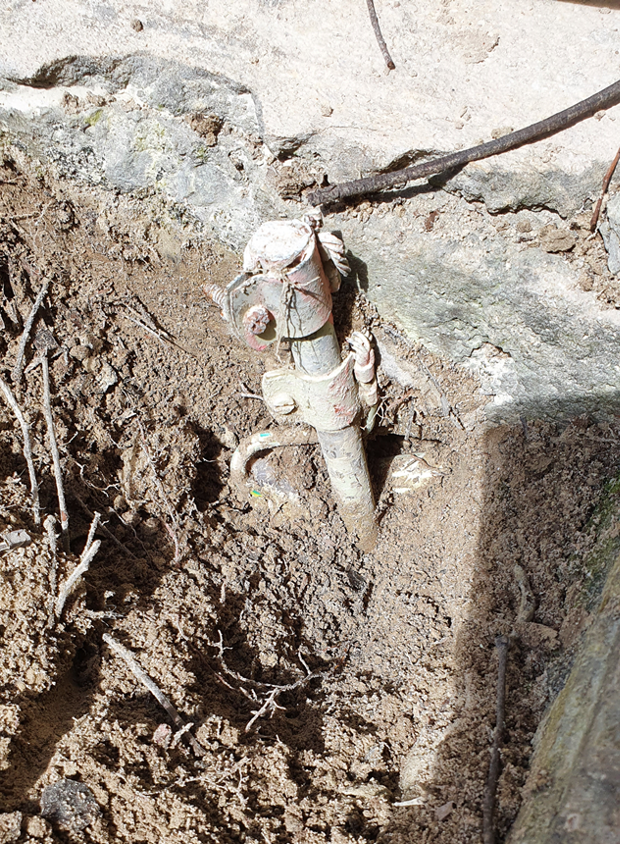
The site had multiple earth stakes. Testing showed intermittent continuity. Two stakes were 12 & 16Ω respectively, the achieved system impedance fluctuated between 9.8 and 12Ω. This was enough to significantly reduce the fault current so that the breaker wouldn’t trip.
Testing Conducted

- Testing showed high voltage
- Earth system wouldn’t have been at earth potential
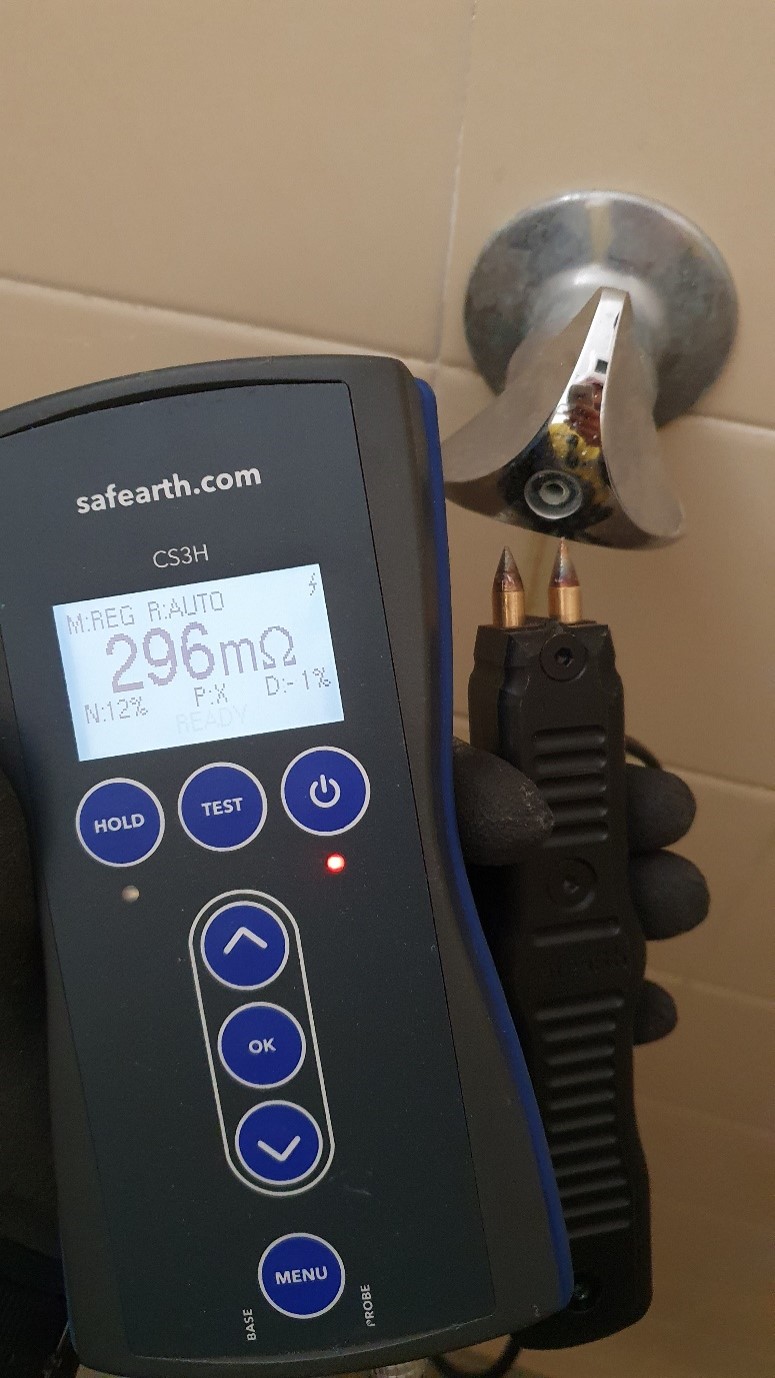
- The tap was bonded to earth, but not very well
- 16Ω from earth to Neutral
- 4Amps
- Not enough current to operate protection
- The supply stayed on
The Fault Circuit – Diagram 2

Relating to the above fault circuit diagram:
- This is when our maintenance worker turned up.
- The worker touched the tap and became part of the circuit and current flowed through him.
- Luckily, it wasn’t enough current to cause damage. The worker was able to let go of tap and didn’t go into atrial fibrillation.
- It was a very dangerous situation and could have led to a fatality. The variety of delayed-action human failures committed long before an emergency state could be recognized. These disasters were due to the adverse conjunction of many causal factors, each one necessary but singly insufficient.
What went wrong? What was done to fix it?
After our investigation, we offered our recommendations to fix this potentially dangerous safety issue. This is what the quarry staff implemented:
- They put in an MEN bond.
- They fixed the local earth stakes.
- They improved equipotential bonding throughout the building.
- They put in RCD’s at the LV distribution board.
- All the plumbing and wiring to the decommissioned unit was removed so there was no possible way it could be energised.
- They realised they didn’t understand their power and earthing system well enough so they gathered documentation and started a project to standardise configurations onsite.
- They started to undertake ongoing maintenance.
Conclusions and Lessons Learnt
- Remember that systems fail, and mistakes get made.
- Problems can remain as latent issues for years.
- The more layers of protection, the less likelihood of damage.
- Make sure decommissioning is done properly.
- Set a maintenance schedule and conduct routine testing to ensure AS3000 met.
- Develop an Electrical Safety Management Plan (ESMP) and follow it
- Install RCD’s.
Through concise investigation, testing and well thought out solutions, Safearth were able offer advice to help this quarry remedy this critical onsite safety issue and protect future staff from electric shock.
Safearth Consultant: Rowan McMurray & Benton Greive, Senior Engineers
